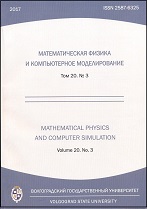|
Mathematics
Harmonic analysis of periodic sequences at infinity
A. A. Ryzhkova
Voronezh State University
Abstract:
Let $ X $ be a complex Banach space and $ \mathrm{End} X $ be a Banach algebra.
By $ l ^ {\infty} = l ^ {\infty} (Z, X) $ we denote the Banach space of two-sided sequences of vectors in X with the norm
$ \|x\|_ {\infty} =\sup \limits_ {n\in \mathbb{Z}}
\|x(n)\| $, $ X: \mathbb{Z} \rightarrow X $, $ x \in l ^ {\infty} $.
By $ c_0 $ we denote the (closed) subspace of sequences of $ l ^ {\infty} $, decreasing at infinity, i.e.
$ \lim \limits_ {n \rightarrow \infty} \|x (n)\| = 0 $.
In the space $ l ^ {\infty} $, let us consider the group of operators
$ S (n): l ^ {\infty } \rightarrow l ^ {\infty} $, $ n \in \mathbb{Z}$
where $ (S (n) x) (k) = x (k + n) $, $ k \in \mathbb{Z}, x \in l ^ {\infty}$.
The sequence $ x \in\ l^{\infty} $ is called slowly varying at
infinity if $S(1) x - x \in c_0$, i.e.
$$
\lim_{N \rightarrow \infty}\|x (n+1)-x (n)\|= 0.
$$
The sequence ${x} $ of $ {l} {} ^ {\infty} $ is called periodic at infinity period $ N \geq 1 $,
$ N \in \mathbb{N} $, if $ {S} (N) {x} - {x} \in {c}_0$.
An example of a sequence slowly varying at infinity is sequence
$ x (n) = \sin (\ln (\alpha + n)) $, $ n \in \mathbb{Z} $,
where $\alpha > 0 $.
The set of slowly varying at infinity sequences form a closed subspace of
$ l ^ {\infty} $ which is denoted by $ l_ {sl, \infty} ^ {\infty} $.
The set of periodic at infinity period $N$ form a closed subspace of
$ l ^ {\infty} $, which is denoted by $ l_ {N, \infty} ^ {\infty} $.
Note that $ c_0 \subset {l_ {sl, \infty} ^ {\infty} }\subset l_{N, \infty}^{\infty }$ for any $ N \geq 1 $.
Suppose that $ \gamma_k = e^{\frac {i2 \pi k}{N}} $,
$ 0 \leq k \leq N-1 $,—the roots of unity. Note that they form a group, denoted further by $ G_N $.
One of the main results is
Theorem 1.
Each periodic at infinity sequence $ x \in l ^{ \infty} $ period $ N \geq 1 $ representation of the form
\begin{equation*}
x(n)=\sum\limits_{k=0}^{N-1} x_k(n)\gamma_k ^n,
\end{equation*}
where $ x_k \in l_ {sl, \infty} ^{ \infty}, 0 \leq k \leq N-1 $.
In a Banach space $l ^ {\infty} (\mathbb {Z}, X) $, where $ X$—finite-dimensional Banach space, consider the difference equation
\begin{equation}
X (n + N) = Bx (n) + y (n),\ n \in \mathbb {Z}, \tag{1}
\end{equation}
where $ y \in c_0 (\mathbb {Z}, X), B\in \mathrm{End} X $ with the property
$ \Sigma_0 = \sigma (B) \cap \mathbb {T} =$ $\{\gamma_1, \gamma_2 ..., \gamma_m\}$—set of simple eigenvalues, where
$\mathbb{T} = \{\lambda \in \mathbb {C}: |\lambda| = 1\} $ and $ \sigma (B) $
denotes the spectrum of the operator
$B$.
Theorem 2.
Each bounded solution $ x: \mathbb {Z} \rightarrow X $ of the equation (1) is a periodic sequence at infinity, which is a representation of the form
$$ X (n) = \sum \limits_ {k = 1} ^ {N} x_k (n) \gamma ^ n_k, $$
where $ x_k \in l ^ {\infty} _ {sl, \infty} $, $ \gamma_k \in \mathbb {T} $, $ 0 \leq k \leq $ N-1.
Keywords:
periodic sequences at infinity, difference equations, eigenvalues, spectral decomposition, projectors.
Citation:
A. A. Ryzhkova, “Harmonic analysis of periodic sequences at infinity”, Vestnik Volgogradskogo gosudarstvennogo universiteta. Seriya 1. Mathematica. Physica, 2017, no. 1(38), 22–32
Linking options:
https://www.mathnet.ru/eng/vvgum160 https://www.mathnet.ru/eng/vvgum/y2017/i1/p22
|

|




 Contact us:
Contact us: Terms of Use
Terms of Use
 Registration to the website
Registration to the website Logotypes
Logotypes








 Citation in format
Citation in format 